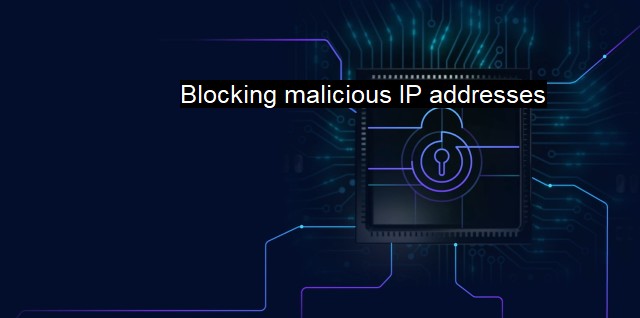What are Blocking malicious IP addresses?
Enhancing Cybersecurity: Significance of Blocking Malicious IP Addresses in Preventing Increasing Cyber Threats
"Blocking malicious IP addresses" refers to a defensive strategy employed within cybersecurity to prevent harmful or unauthorized access to sensitive or private data and resources. With the constant advancements in technology, handling cybersecurity issues has become a top priority for businesses and individuals alike. Therefore, understanding an IP address's operation, recognising the potential threats incurred, and devising effective security measures are of paramount importance.An IP address, or Internet Protocol address, has a significant role. This numeric label assigned to each device participating in a computer network allows communication through the Internet Protocol. An IP address is akin to a home address for your device, delivering information and data packets between source and target—a sender and a receiver.
Malicious IP addresses pose a significant security threat. These addresses often emanate from hackers trying to defile or breach a system. Sometimes, it could also result from a compromised device within a network, acting as an attack conduit for harmful elements. The activities associated with harmful IP addresses include DDoS attacks, phishing, scanning for system vulnerabilities, spamming, transmitting malware, and a variety of other cyber threats.
To combat such threats, blocking malicious IP addresses becomes integral for your online security. The process involves identifying and preventing the harmful source from accessing sensitive data or infecting a network by explicitly stopping data exchange with it.
The blocking of harmful IP addresses is usually executed by incorporating firewalls, intrusion detection systems (IDS), or intrusion prevention systems (IPS). These mechanisms work by setting up rules against dubious IP addresses, averting any traffic from them to reach your system. IDS and IPS further sophisticate the process by detecting any intrusion pattern and effectively blocking that address.
Blocking these addresses immediately adds a layer of protection to the system. it frees system resources from handling worthless or harmful data, enhancing the performance. While this doesn't completely eliminate the threat of cyberattacks, it is a significant first step towards solidifying a network's security foundation.
Blacklisting is another popular technique employed by cybersecurity experts and antivirus software. It includes a list of all known threatening IP addresses which are automatically blocked from interacting with the network or individual devices.
Addressing cybersecurity threat is an ever-on-going process. The reason being, no sooner does one IP address get blocked, malicious entities promptly shift to another. Cybersecurity is an evolving field, the viruses, malware and harmful elements evolve rapidly, as do their distribution methods.
Efforts persist in recognizing and consequently preventing threats from unidentified harmful IP addresses. Organizations often rely on a combination of machine learning algorithms and behavioural analysis to make an educated prediction about potentially dangerous IP addresses, refining their security practices.
Reporting dubious IP addresses to the respective internet service provider (ISP) or relevant entities further enhances collective security. In some instances, a hacked IP might even belong to an innocent user ignorant of the malicious activities carried out through his device. Making ISPs aware fosters greater security and facilitates negligence curtailment at a larger scale.
Blocking malicious IP addresses ultimately aims at solidifying digital fences, keeping unwanted intruders at bay. While the key is to remember that 100% cyber protection might be unrealistic, preventative perimeter security by blocking damaging IPs is a proactive step against cyber insecurity, allowing to safeguard one's private and sensitive data from falling into the wrong hands. Therefore, fortify your awareness and stay on guard. Informative vigilance, coupled with practical steps like blocking malicious IP addresses, certainly creates a stronger cybersecurity environment.

Blocking malicious IP addresses FAQs
What is the purpose of blocking malicious IP addresses?
Blocking malicious IP addresses is an important cybersecurity measure that prevents attackers from accessing your network or system. By blocking these malicious IPs, you can prevent them from launching attacks, stealing data, or causing other types of damage.How do I identify malicious IP addresses?
There are many tools and techniques available for identifying malicious IP addresses, including firewalls, intrusion detection systems, and threat intelligence feeds. You can also use antivirus software or online resources like the Malware Hash Registry to identify known malicious IPs.What are some best practices for blocking malicious IP addresses?
To effectively block malicious IP addresses, you should use a combination of techniques, such as configuring your firewall to block incoming traffic from known malicious IPs, using blacklists or whitelists to filter traffic, and monitoring your network for suspicious activity. You should also regularly update your security software and keep track of new threats and attack methods.Are there any risks associated with blocking malicious IP addresses?
While blocking malicious IPs is an important security measure, it is important to ensure that you are not blocking legitimate traffic or services. If you block an IP address that is used by a legitimate user or service, it can cause disruptions or false alarms. Additionally, some attackers may use dynamic or constantly changing IP addresses, which can make it difficult to identify and block them effectively.| | A | | | B | | | C | | | D | | | E | | | F | | | G | | | H | | | I | | | J | | | K | | | L | | | M | |
| | N | | | O | | | P | | | Q | | | R | | | S | | | T | | | U | | | V | | | W | | | X | | | Y | | | Z | |
| | 1 | | | 2 | | | 3 | | | 4 | | | 7 | | | 8 | | |||||||